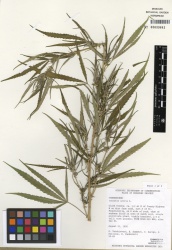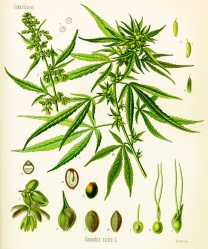|
AHPA recognizes other valuable resources exist regarding the identity of Cannabis spp..
To submit a suggestion or contribution, please contact Merle Zimmermann.
|
Nomenclature
Cannabis sativa L. Cannabaceae
Botanical Voucher Specimen
 |
|

Source: MOBOT, Tropicos.org[1]
|
Organoleptic Characteristics
|
Scent Narcotic type (heavy,nauseating, and suffocating;increased by moisture)
Source: American Herbal Products Association. March 2013. Organoleptic Analysis of Herbal Ingredients. AHPA: Silver Spring, MD [2]
|
|
|
|
|
Macroscopic Characteristics
| “…Cannabis is an annual, dioecious (the flowers on individual plants are unisexual), flowering herb. Staminate (male) plants are usually taller but less robust than pistillate (female) plants.”
“…Stem is green, erect, hollow and longitudinally grooved. It can vary from 0.2-6 m, although most of the plants reach heights of 1-3 m. The extent of branching, like plant height, depends on environmental and hereditary factors as well as the method of cultivation. The side branches vary from opposite to alternate at any part of the main stem. The leaf arrangement changes from decussate (oppositely arranged) to alternate on the extremities of the plant. Leaf stalks (petioles) are 2-7 cm long with a narrow groove along the upper side. The leaf is palmate and consists of 3-9 linear-lanceolate leaflet blades of 3-15 x 0.2-1.7 cm. The margins are coarsely serrated, the teeth pointing towards the tips; the veins run out obliquely from the midrib to the tips of the teeth. The lower (abaxial) surfaces are pale green with scattered, white to yellowish brown, resinous glands.”
“…The pistillate (female) flowers are more or less sessile and are borne in pairs. Each flower has a small green bract enclosing the ovary with two long, slender stigmas projecting well above the bract.”
Source: Recommended methods for the identification and analysis of cannabis and cannabis products, United Nations Office on Drugs and Crime, Vienna, 2009. (ST/NAR/40) [3]
|
|
|
|
|

Source: Köhler, Medizinal-Pflanzen in naturgetreuen Abbildungen und kurzerläuterndemTexte (1887)[4]
|
|
Microscopic Characteristics
Gas Chromatography Identification
High Performance Thin Layer Chromatographic Identification
Supplementary Information
Sources
- ↑ MOBOT, Tropicos.org http://www.tropicos.org/Image/100003863
- ↑ American Herbal Products Association. March 2013. Organoleptic Analysis of Herbal Ingredients. AHPA: Silver Spring, MD http://www.ahpa.org/default.aspx?tabid=419
- ↑ Recommended methods for the identification and analysis of cannabis and cannabis products, United Nations Office on Drugs and Crime, Vienna, 2009. (ST/NAR/40) http://www.unodc.org/documents/scientific/ST-NAR-40-Ebook.pdf
- ↑ Köhler, Medizinal-Pflanzen in naturgetreuen Abbildungen und kurzerläuterndemTexte (1887)

